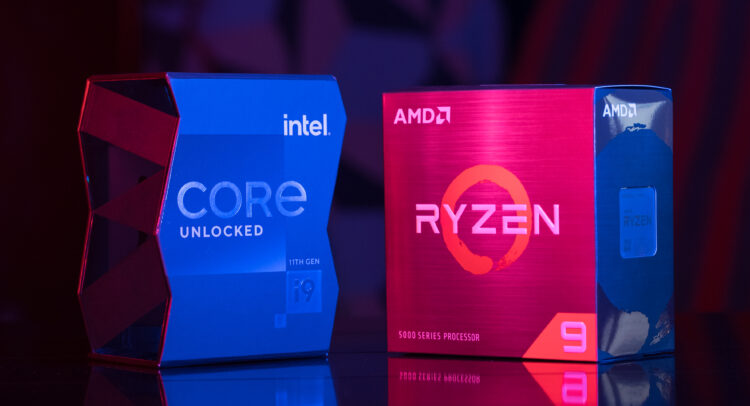In this piece, I evaluated two semiconductor stocks, Intel (NASDAQ:INTC) and Advanced Micro Devices (NASDAQ:AMD), using TipRanks’ Comparison Tool to see which is better. A closer look suggests neutral views of both, although a clear winner emerges upon deeper analysis.

While both companies are in the semiconductor business, Intel still makes a lot of chips for PCs and laptops. In 2023, 40% of its revenue came from only three customers: Dell (NYSE:DELL), HP (NYSE:HPQ) and Lenovo. The company also differs from AMD in that it fabricates its own chips in-house.
On the other hand, AMD is a so-called “fabless” chipmaker, meaning it operates no fabrication facilities. AMD targets specific areas of technology, such as artificial intelligence, data centers, and gaming.
Shares of Intel have tumbled 32% year-to-date but are up 5% over the last year, while AMD stock has soared 20% year-to-date and is up 56% over the last year.
With such a dramatic difference in their share-price performances, a closer look is needed to determine why and whether it’s warranted. We’ll compare their price-to-earnings (P/E) ratios to gauge their valuations against each other and that of their industry.
For comparison, the semiconductor industry is trading at a P/E of 64.1x, significantly higher than its three-year average of 35.2x.
Intel (NASDAQ:INTC)
At a P/E of 36.5x, Intel is trading in line with the semiconductor industry’s three-year average and at a discount to its current valuation. Its forward P/E (next 12 months) of 27.5x makes the stock look even more attractive, but for now, a neutral view seems appropriate, as Intel is currently a bit of a show-me story.
On the one hand, many of the things that have given AMD the edge over Intel appear to be changing. For example, one thing that has enabled chipmakers like AMD to excel is moving their chip fabrications from in-house to third parties like Taiwan Semiconductor Manufacturing (NYSE:TSM).
Running fabrication facilities is expensive, so fabless chipmakers have had the edge. However, Intel is actually tapping into this advantage by contracting TSM for its upcoming Lunar Lake chips. The chipmaker is also working on bringing its fabrication facilities up to date to support the latest chip-making technologies.
Additionally, Intel has been a laggard in the artificial intelligence department. However, Melius Research analysts said in a recent report that this could change in the second half of 2024. Of course, the keyword in that sentence is “could,” as we have no idea whether this will actually happen. Thus, buying Intel stock right now seems like a bit of a gamble.
Traditionally, Intel has ruled the roost in laptop and PC chips, so we’re also waiting to see any progress in areas like AI, data centers, the cloud, and the Internet of Things. The chipmaker is also just coming out of overbought territory regarding its Relative Strength Index, suggesting the potential for another near-term pullback before things get better.
What Is the Price Target for INTC Stock?
Intel has a Hold consensus rating based on three Buys, 24 Holds, and three Sell ratings assigned over the last three months. At $38.02, the average Intel stock price target implies upside potential of 13.5%.

Advanced Micro Devices (NASDAQ:AMD)
Advanced Micro Devices has been trading at a premium to its industry for quite some time, so its current P/E of 268x is no surprise. The company’s forward P/E of 45.9x looks far more reasonable and is a discount to the industry’s current valuation. However, a neutral view may be appropriate, at least until after the next earnings report.
AMD has an earnings report due soon, possibly toward the end of July, and it could turn out to be a significant catalyst — either to the upside or downside. Thus, investors have to consider whether they think expectations are already baked into the stock.
AMD sits at a critical juncture right now. As a result, all it might take is an in-line earnings report to trigger a buy-the-dip opportunity. On the other hand, a blowout report would send shares significantly higher, meaning investors would have to watch and wait longer for a decent entry price.
Reviewing AMD’s first-quarter results calls into question the many comparisons with Nvidia (NASDAQ:NVDA). In its latest quarter, Nvidia’s revenue skyrocketed due to its AI chips, but AMD continues to lag behind in that area — despite signs that it’s catching up.
In the latest quarter, AMD was barely profitable, posting net income of $123 million on a GAAP (generally accepted accounting principles) basis. Its revenue rose only 2% year-over-year, versus Nvidia’s explosive 262% year-over-year revenue growth. Further, Nvidia’s net income surged 628% year-over-year, leaving AMD in the dust.
What Is the Price Target for AMD Stock?
Advanced Micro Devices has a Strong Buy consensus rating based on 28 Buys, seven Holds, and zero Sell ratings assigned over the last three months. At $191.57, the average AMD stock price target implies upside potential of 5.3%.

Conclusion: Neutral on INTC and AMD
While AMD is the clear winner of this pairing because it appears closer to deserving a bullish view, I’d prefer to wait for a more attractive entry point into its stock. Intel could deserve a bullish view if analysts’ expectations do come to pass, but I’d like to see evidence that the changes underway currently will move the needle for the chipmaker. In particular, Intel needs to move beyond PCs and laptops to take a bite into the markets for AI and other newer technologies.
Questions or Comments about the article? Write to editor@tipranks.com
















